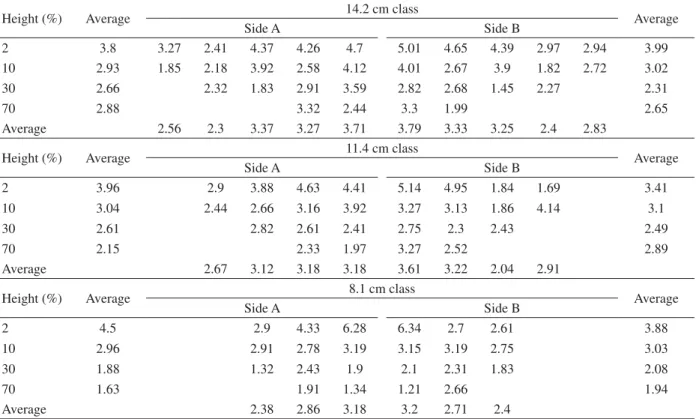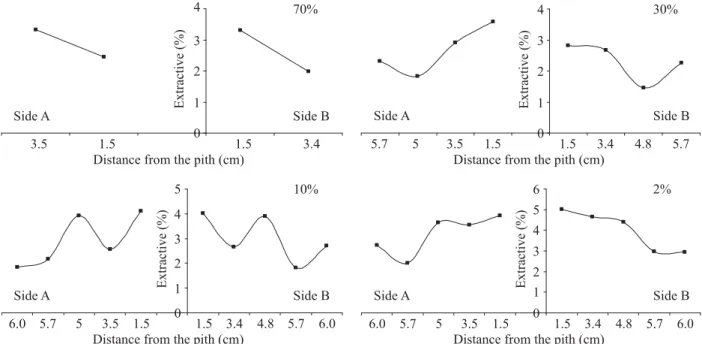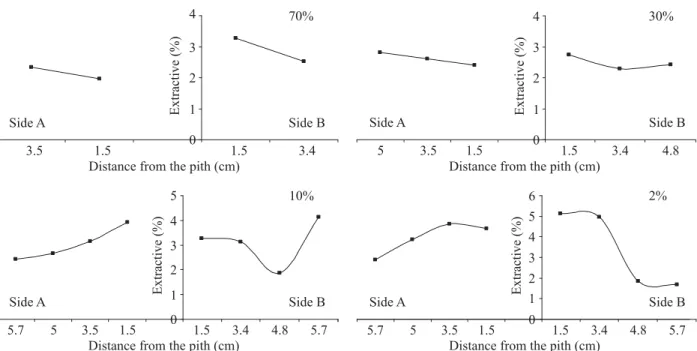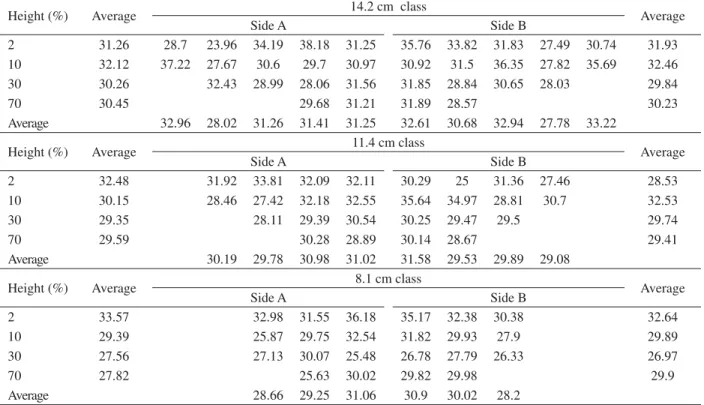IN A CLONE OF Eucalyptus grandis W.Hill ex Maiden x Eucalyptus urophylla S. T. Blake
Marina Donária Chaves Arantes1, Paulo Fernando Trugilho2, José Tarcísio Lima3, Angélica de Cássia Oliveira Carneiro4, Eduardo Alves5, Mário César Guerreiro6 (received: January 14, 2010; accepted: April 28, 2011)
ABSTRACT: The objective of this work was to determine concentrations of extractives and total lignin along with their radial and longitudinal variations in wood from a clone of Eucalyptus grandis W.Hill ex Maiden x Eucalyptus urophylla S. T. Blake at age six years. Longitudinal samples were taken at 2%, 10%, 30% and 70% of the commercial height of trees, and radial samples were taken from each longitudinal position, the number of samples depending on the diameter of each disk. Results led to the conclusion that, overall, concentrations of extractives and total lignin in the wood tended to decrease with increasing distance from the pith and tended to increase in portions closer to the tree base.
Key words: Wood, Eucalyptus, chemical components.
VARIAÇÃO LONGITUDINAL E RADIAL DOS TEORES DE EXTRATIVOS E LIGNINA TOTAL DO CLONE DE Eucalyptus grandis W.Hill ex Maiden x Eucalyptus urophylla S. T. Blake
RESUMO: Objetivou-se, com este trabalho, determinar os teores de extrativos e lignina total e suas variações radiais e longitudinais na madeira do clone de Eucalyptus grandis W.Hill ex Maiden x Eucalyptus urophylla S. T. Blake, aos seis anos de idade. Foram retiradas amostras no sentido longitudinal a 2, 10, 30 e 70% da altura comercial da árvore, e no sentido radial de cada posição longitudinal, sendo que o número de amostras dependeu do diâmetro do disco. Pelos resultados obtidos, concluiu-se que: os teores de extrativos e lignina total na madeira apresentaram, em geral, variação decrescente com a distância da medula e tenderam a uma maior concentração nas regiões mais próximas à base das árvores.
Palavras-chave: Madeira, Eucalyptus, componentes químicos.
.
1Forest Engineer, Professor, Ph.D. in Wood Science and Technology – Centro de Ciências Agrárias/CCA – Universidade Federal do Espírito Santo/UFES – 29.500-000 –Alegre, ES, Brasil – mdonariac@hotmail.com
2Forest Engineer, Professor, Ph.D. in Forest Science – Departamento de Ciências Florestais – Universidade Federal de Lavras – Cx. P. 3037 – 37200-000 – Lavras, MG, Brasil – trugilho@dcf.ufl a.br
3Forest Engineer, Professor, Ph.D. in Forest Sciences – Departamento de Ciências Florestais/DCF – Universidade Federal de Lavras/UFLA – Cx.P. 3037 – 37200-000 – Lavras, MG, Brasil – jtlima@dcf.ufl a.br
4Forest Engineer, Professor, Ph.D. in Forest Science – Departamento de Engenharia Florestal – Universidade Federal de Viçosa/UFV – 36570-000 – Viçosa, MG, Brasil – cassinhacarneiro@yahoo.com.br
5Agonomic Engineer, Professor Ph.D. in Agronomy – Departamento de Fitopatologia – Universidade Federal de Lavras/UFLA – 37200-000 – Lavras, MG, Brasil – ealves@dfp.ufl a.br
6Chemist, Professor Ph.D. in Chemistry – Departamento de Química/DQI – Universidade Federal de Lavras/UFLA – 37200-000 – Lavras, MG, Brasil – guerrero@dqi.ufl a.br
1 INTRODUCTION
When considering constituent elements of wood, a distinction should be made between the macromolecular components of the cell wall, namely cellulose, hemicelluloses and lignin.
Cellulose is the chief component of wood and accounts for half the material contained in both softwoods and hardwoods. It is characterized as a linear polymer of
high molecular weight, composed exclusively of ß-D-glucose. Due to its chemical and physical properties as well as its supramolecular structure, it is the chief component of the cell wall of plants. Hemicelluloses, in turn, are in close relation with cellulose in the cell wall. Their molecular chains are much shorter than those in cellulose, there
possibly being side groups and chain branching in some cases. Overall, hardwood has higher polyose contents than softwood, and its composition is differentiated (KLOCK et al., 2005).
Another constituent of the cell wall is lignin, an aromatic, three-dimensional, high molecular weight polymer, having hydroxylated and methoxylated
phenylpropane as a structural base, depending on the type
of wood. Lignin is closely associated with hemicelluloses, not only through physical interaction but also through chemical bonding (BARRICHELO; BRITO, 1985). Lignin is considered more hydrophobic than other wood components and thus acts as a cementing, adhesive material
among fi bers (PETTERSEN, 1984), besides imparting
Information about variations in lignin content is scarce in literature, both longitudinally and radially in relation to the log.
In a study about variation of physicochemical characteristics in Eucalyptus wood with age, Trugilho et al. (1996) found a negative correlation between basic density and lignin content, suggesting that high lignin content woods have lower basic density. These authors concluded that chemical characteristics are subject to considerable initial variations in juvenile wood but tend to become more stable in mature wood.
The remaining components of wood, present in smaller quantities, are low molecular weight compounds known as extractives, which are found particularly in the bark and include terpenes, oils, gums, tannins, coloring matter etc.
According to Pereira et al. (2000), extractives are accidental chemical compounds unessential for the structure of the cell wall and middle lamella, being soluble in water or other neutral organic solvents. Among extractives, they cite terpenes, resins, volatile oils, gums, waxes and tannins. According to Lima et al. (2007), volatile extractives known as essential oils are responsible for the characteristic odor of plants, being present in signifi cant quantities in gymnosperms but in smaller proportion in angiosperms. These compounds are constituted by terpenes, alcohols, esters, aldehydes, ketones, organic acids, aliphatic hydrocarbons and low molecular weight phenols.
Silvério et al. (2006) studied a methodology for extraction and determination of extractives content in eucalyptus woods and observed that, for E. urophylla x
E. grandis, the (2:1) toluene:ethanol mixture was more
effective in removing total extractives, whose average content was 2.23%.
The objective of this work was to determine concentrations of extractives and total lignin, along with their radial and longitudinal variations, in wood from a clone of Eucalyptus grandis W.Hill ex Maiden x
Eucalyptus urophylla S. T. Blake at age six years.
2 MATERIAL AND METHODS
Fifty trees were sampled from a clonal stand of
Eucalyptus urophylla x Eucalyptus grandis at age 6 years,
planted with 3 x 2 m spacing and provided by ArcelorMittal Florestas. The clonal stand was located in Martinho Campos, Minas Gerais State. In the sampling site, a plot consisting of 10 rows x 10 plants was launched and the diameter of all trees was measured for classifi cation by diameter.
Three diameter classes were established and the number of sampled trees per class was defi ned by their participative percentage in relation to the population, as can be seen in Table 1. Once the number of individuals per diameter class was defi ned, trees within these intervals were selected.
Table 1 – Tree distribution in a clonal stand of Eucalyptus grandis
W.Hill ex Maiden x Eucalyptus urophylla S. T. Blake according
to diameter class.
Tabela 1 – Distribuição das árvores do clone de Eucalyptus grandis W.Hill ex Maiden x Eucalyptus urophylla S. T. Blake nas classes diamétricas
Class (cm) Class midpoint
(cm) Frequency
Participation in the population (%)
12.8 to 17.0 14.2 23 47
9.7 to 12.7 11.4 19 38
3.1 to 9.5 8.1 8 15
Total 50 100
For determination of the extractives and total lignin contents, longitudinal samples were taken from the 2%, 10%, 30% and 70% log portions along the commercial height. As regards radial samples from each longitudinal position, the number of samples was conditional on the diameter of the disk (side A and side B, considering the pith as midpoint). The reason for this alternative sampling being at the 2%, 10%, 30% and 70% portions of the commercial height was that these sections provided the best results in a study conducted by Pádua (2009) using the same clone of Eucalyptus grandis W.Hill ex Maiden
x Eucalyptus urophylla S. T. Blake.
Extractives were measured according to standard M 3/69 of the Brazilian pulp and paper technical association, Associação Brasileira Técnica de Celulose e Papel – ABCP (1974). Insoluble lignin (Klason lignin) was measured according to descriptions by Gomide and Demuner (1986). The soluble lignin content in sulfuric acid was determined by spectrophotometry, using the equation described by Goldschimid (1971). The total lignin content resulted from the aggregate of soluble and insoluble lignin contents.
3 RESULTS AND DISCUSSION
As was observed in the 14.2 cm class, overall, the concentrations of extractives tend to decrease in the pith to bark direction, and the same pattern is noted for the 11.4 cm and 8.1 cm classes.
For the 14.2 cm class, an initial reduction is followed by an increase in the values of total extractives from the base to the top of trees. The 11.4 cm class showed the same pattern.
The average extractives content, all three diameter classes being considered, was 2.91%, differing from values in literature. Silvério et al. (2006), for instance, while studying a methodology to extract and determine
extractives in wood from Eucalyptus urophylla, E.
camaldulensis and E. urophylla x E. grandis, found an
average value of 2.23%.
It was noted, for the 14.2 cm class, that the total extractives content tends to decrease up to the 30% height portion and then increase at the 70% height portion of the trunk. This increase is likely related to higher sugar quantities in taller parts of the trunk, closer to the apical
meristem. Silva et al. (2005) investigated the infl uence
of age and position relative to the trunk on the chemical
composition of wood from Eucalyptus grandis Hill ex.
Maiden and found that older, lower log sections had higher extractives and lignin contents than remaining log sections, corresponding to maturer wood, and they also found that younger, higher log sections had higher holocellulose contents.
For the 11.4 cm class, it was noted that the total extractives content tends to decrease up to the 30% height portion and then increase at the 70% height portion of the trunk. This increase is likely related to the higher concentration of low molecular weight carbohydrates in taller parts of the trunk, closer to the apical meristem. This data agree with values found in literature, as for instance results described by Silva et al. (2005).
For the 8.1 cm class, longitudinal variation in total extractives content tends to decrease considerably with increasing relative height and then stabilize at the 70% height portion of the trunk.
Table 2 – Average values of total extractives according to radial and longitudinal positions, in wood from a clone of Eucalyptus grandis W.Hill ex Maiden x Eucalyptus urophylla S. T. Blake.
Tabela 2 – Valores médios dos teores de extrativos totais por posição radial e longitudinal da madeira do clone de Eucalyptus grandis W.Hill ex Maiden x Eucalyptus urophylla S. T. Blake.
Height (%) Average 14.2 cm class Average
Side A Side B
2 3.8 3.27 2.41 4.37 4.26 4.7 5.01 4.65 4.39 2.97 2.94 3.99
10 2.93 1.85 2.18 3.92 2.58 4.12 4.01 2.67 3.9 1.82 2.72 3.02
30 2.66 2.32 1.83 2.91 3.59 2.82 2.68 1.45 2.27 2.31
70 2.88 3.32 2.44 3.3 1.99 2.65
Average 2.56 2.3 3.37 3.27 3.71 3.79 3.33 3.25 2.4 2.83
Height (%) Average 11.4 cm class Average
Side A Side B
2 3.96 2.9 3.88 4.63 4.41 5.14 4.95 1.84 1.69 3.41
10 3.04 2.44 2.66 3.16 3.92 3.27 3.13 1.86 4.14 3.1
30 2.61 2.82 2.61 2.41 2.75 2.3 2.43 2.49
70 2.15 2.33 1.97 3.27 2.52 2.89
Average 2.67 3.12 3.18 3.18 3.61 3.22 2.04 2.91
Height (%) Average 8.1 cm class Average
Side A Side B
2 4.5 2.9 4.33 6.28 6.34 2.7 2.61 3.88
10 2.96 2.91 2.78 3.19 3.15 3.19 2.75 3.03
30 1.88 1.32 2.43 1.9 2.1 2.31 1.83 2.08
70 1.63 1.91 1.34 1.21 2.66 1.94
Figure 1 illustrates radial variation in total extractives content within the 14.2 cm class, per relative height. A decreasing tendency was noted in the extractives content with increasing distance from the pith, in all heights being considered, except the 70% height portion (side A). In the position closer to the bark an increasing tendency was noted in extractives content, possibly related to higher sugar contents in such areas, close to the vascular cambium. In the part facing the pith, the higher amount of extractives is likely related to heartwood formation and, consequently, more polyphenols present.
Figure 2 illustrates radial variation of total extractives content for diameter class 11.4 cm, per relative height. A decreasing tendency in extractives content is noted with increasing distance from the pith, for the 2% and 10% height portions of the commercial trunk. This tendency is more noticeable at 2%. At 10% (side B), an abrupt increase occurred in the position closer to the bark, possibly caused by the presence of resin pockets (kino), a very common occurrence in Eucalyptus wood. In positions closer to the bark there is an increasing tendency in the extractives content, possibly related to high sugar contents in such areas, close to the vascular cambium. In the part facing the pith, the higher amount of extractives is likely
Figure 1 – Radial variation of total extractives content in wood from a clone of Eucalyptus grandis W.Hill ex Maiden x Eucalyptus urophylla S. T. Blake, for diameter class 14.2 cm.
Figura 1 – Variação radial para o teor de extrativos totais da madeira do clone de Eucalyptus grandis W.Hill ex Maiden x Eucalyptus urophylla S. T. Blake para a classe diamétrica 14,2 cm.
related to heartwood formation and, consequently, more polyphenols present. These results were similar to values found for the 14.2 cm class.
The radial variation of total extractives content for diameter class 8.1 cm per relative height is illustrated in Figure 3. The variation was found to be similar to that found in the other two diameter classes, as discussed earlier. In positions closer to the bark there is an increasing tendency in extractives content, possibly related to higher sugar contents in such areas, close to the vascular cambium. A higher content is observed at the 2% height portion, in comparison to classes 14.2 cm and 11.4 cm. This reinforces the idea that these extractives are mainly composed of low molecular weight carbohydrates which are present in sapwood, and given that the diameter class 8.1 cm has low percentage of heartwood. Overall, results were similar to fi ndings for diameter classes 11.4 cm and 14.2 cm.
Average values of total lignin content, according to each relative height, radial position and diameter class, are illustrated in Table 3.
Figure 2 – Radial variation of total extractives content in wood from a clone of Eucalyptus grandis W.Hill ex Maiden x Eucalyptus urophylla S. T. Blake, for diameter class 11.4 cm.
Figura 2 – Variação radial do teor de extrativos totais na madeira do clone de Eucalyptus grandis W.Hill ex Maiden x Eucalyptus urophylla S. T. Blake para a classe diamétrica 11,4 cm.
Figure 3 – Radial variation of total extractives content in wood from a clone of Eucalyptus grandis W.Hill ex Maiden x Eucalyptus urophylla S. T. Blake, for diameter class 8.1 cm.
Similarly to diameter class 14.2 cm, with diameter class 11.4 cm the highest lignin contents were overall found in positions close to the stem base. This could be related to greater proportion of heartwood in portions near the tree base. Haselein et al. (2004) observed a similar pattern, with heartwood percentage showing increasing average values from the base up to the 25% height portion and then decreasing until the 100% height portion, with a general average of 75.7%. An increasing tendency exists in lignin content up to the 10% height portion, followed by a reduction and then stabilization at the 30% and 70% height portions of the commercial trunk.
For diameter class 8.1 cm, higher lignin contents were found in base positions, particularly at the 2% height portion, similarly to diameter classes 14.2 cm and 11.4 cm. This could be related to higher proportion of heartwood in portions close to the tree base, particularly in this small diameter class on account of the small percentage of heartwood present. A decrease was observed after the 2% height portion, and from the 10% height portion onward lignin contents remained more or less unchanged.
Figure 4 illustrates radial variation of total lignin content in wood from a clone of Eucalyptus grandis W.Hill ex Maiden x Eucalyptus urophylla S. T. Blake for diameter class 14.2 cm per relative height. The lignin content failed to show a well defi ned pattern of radial variation. Yet it was observed that, overall, higher lignin contents are found near the pith while lower lignin contents are found near the sapwood.
Lignin quantity is an important parameter for putting wood to different uses. As discussed by Andrade (1993), the chemical composition of wood exerts considerable influence over the physicochemical properties of charcoal inasmuch as when lignin rich wood is carbonized, a high gravimetric yield is obtained along with a high carbon content charcoal. This relates to greater resistance by lignin to thermal breakdown than by other structural components in wood.
Figure 5 provides radial variation of total lignin
content in wood from a clone of Eucalyptus grandis
W.Hill ex Maiden x Eucalyptus urophylla S. T. Blake
for diameter class 11.4 cm per relative height. Here, the
Table 3 – Average values of total lignin content (%), according to each relative height, radial position and diameter class, in wood
from a clone of Eucalyptus grandis W.Hill ex Maiden x Eucalyptus urophylla S. T. Blake.
Tabela 3 – Valores médios do teor de lignina total (%) por altura relativa, posição radial de amostragem e classe diamétrica na madeira do clone de Eucalyptus grandis W.Hill ex Maiden x Eucalyptus urophylla S. T. Blake.
Height (%) Average 14.2 cm class Average
Side A Side B
2 31.26 28.7 23.96 34.19 38.18 31.25 35.76 33.82 31.83 27.49 30.74 31.93
10 32.12 37.22 27.67 30.6 29.7 30.97 30.92 31.5 36.35 27.82 35.69 32.46
30 30.26 32.43 28.99 28.06 31.56 31.85 28.84 30.65 28.03 29.84
70 30.45 29.68 31.21 31.89 28.57 30.23
Average 32.96 28.02 31.26 31.41 31.25 32.61 30.68 32.94 27.78 33.22
Height (%) Average 11.4 cm class Average
Side A Side B
2 32.48 31.92 33.81 32.09 32.11 30.29 25 31.36 27.46 28.53
10 30.15 28.46 27.42 32.18 32.55 35.64 34.97 28.81 30.7 32.53
30 29.35 28.11 29.39 30.54 30.25 29.47 29.5 29.74
70 29.59 30.28 28.89 30.14 28.67 29.41
Average 30.19 29.78 30.98 31.02 31.58 29.53 29.89 29.08
Height (%) Average 8.1 cm class Average
Side A Side B
2 33.57 32.98 31.55 36.18 35.17 32.38 30.38 32.64
10 29.39 25.87 29.75 32.54 31.82 29.93 27.9 29.89
30 27.56 27.13 30.07 25.48 26.78 27.79 26.33 26.97
70 27.82 25.63 30.02 29.82 29.98 29.9
Figure 4 – Radial variation of total lignin content in wood from a clone of Eucalyptus grandis W.Hill ex Maiden x Eucalyptus urophylla S. T. Blake, for diameter class 14.2 cm.
Figura 4 – Variação radial do teor de lignina total na madeira do clone de Eucalyptus grandis W.Hill ex Maiden x Eucalyptus urophylla S. T. Blake para a classe diamétrica 14,2 cm.
Figure 5 – Radial variation of total lignin content in wood from a clone of Eucalyptus grandis W.Hill ex Maiden x Eucalyptus urophylla S. T. Blake, for diameter class 11.4 cm.
lignin content again failed to show a well defi ned pattern of radial variation. Yet it was observed that, overall, higher lignin contents are found near the pith while lower lignin contents are found near the sapwood, similarly to results found for diameter class 14.2 cm.
Figure 6 provides radial variation of total lignin content in wood from the clone being assessed for diameter
class 8.1 cm, per relative height. Here, lignin content is noted to show a decreasing pattern of radial variation with increasing distance from the pith, particularly at the 2% and 10% portions of the commercial trunk. Also, higher lignin contents were overall found near the pith while lower lignin contents were found near the sapwood, similarly to results found for diameter classes 14.2 cm and 11.4 cm.
Figure 6 – Radial variation of total lignin content in wood from a clone of Eucalyptus grandis W.Hill ex Maiden x Eucalyptus urophylla S. T. Blake, for diameter class 8.1 cm.
Figura 6 – Variação radial do teor de lignina total na madeira do clone de Eucalyptus grandis W.Hill ex Maiden x Eucalyptus urophylla S. T. Blake para a classe diamétrica 8,1 cm.
4 CONCLUSIONS
For diameter class 14.2 cm, a reduction occurred to start with, followed by an increase in amounts of total extractives, from the base to the top of trees. Diameter classes 11.4 cm and 8.1 cm showed a similar pattern.
For diameter class 8.1 cm, higher total lignin contents were found in positions near the tree base, particularly at the 2% height portion. The same happened with diameter classes 14.2 cm and 11.4 cm.
Overall, extractives and total lignin contents in the relevant wood showed decreasing variation with increasing distance from the pith and tended to be concentrated in positions close to the tree base.
5 REFERENCES
ANDRADE, A. M. de. Efeitos da fertilização mineral e da calagem na produção e na qualidade da madeira e do carvão de eucalipto. 1993. 105 f. Tese (Doutorado em Ciência Florestal) – Universidade Federal de Viçosa, Viçosa, 1993.
ASSOCIAÇÃO BRASILEIRA TÉCNICA DE CELULOSE E PAPEL. Normas técnicas ABTCP. São Paulo, 1974.
GOLDSCHIMID, O. Ultraviolet spectra. In: SARKANEN, K. V.; LUDWIG, C. H. Lignins: occurrence, formation, structure and reactions. New York: J. Wiley Interprice, 1971. p. 241-298.
GOMIDE, J. L.; DEMURE, B. J. Determinação do teor de lignina em material lenhoso: método Klason modifi cado. O Papel, São Paulo, v. 47, n. 8, p. 36-38, 1986.
HASELEIN, C. R.; LOPES, M. de C.; SANTINI, E. J.; LONGHI, S. J.; ROSSO, S.; FERNANDES, D. L. G.; MENEZES, L. F. de. Características tecnológicas da madeira de árvores matrizes de Eucalyptus grandis. Ciência Florestal, Santa Maria, v. 14, n. 2, p. 145-155, mar./abr. 2004.
KLOCK, U.; MUNIZ, G. I. B.; HERNANDEZ, J. A.; ANDRADE, A. S. Química da madeira. 3. ed. Curitiba: UFPR, 2005. 86 p.
LIMA, S. R. de; OLIVEIRA, G. S. de; MORAIS, S. A. L.; NASCIMENTO, E. A. do; CHANG, R. Estudo dos constituintes macromoleculares, extrativos voláteis e
compostos fenólicos da madeira de candeia – Moquinia
polymorpha (less.) dc. Ciência Florestal, Santa Maria, v. 17, n. 2, p. 145-155, abr./jun. 2007.
PÁDUA, F. A. de. Amostragem para avaliação da
densidade básica da madeira de um híbrido de Eucalyptus grandis W.Hill ex Maiden x Eucalyptus urophylla S. T.
Blake. 2009. Tese (Doutorado) - Universidade federal de Lavras, Lavras, 2009.
PEREIRA, J. C. D.; STURION, J. A.; HIGA, A. R.; HIGA, R. C. V.; SHIMIZU, J. Y. Características da madeira de algumas espécies de eucalipto plantadas no Brasil. Colombo: Embrapa Florestas, 2000. 113 p. (Embrapa Florestas, Documentos, 38).
PETTERSEN, R. C. The chemical composition of wood. In: ROWELL, R. (Ed.). The chemistry of solid wood. Washington: American Chemical Society, 1984. p. 54-126.
SILVA, J. de C.; MATOS, J. L. M. de; OLIVEIRA, J. T. da
S.; EVANGELISTA, W. V. Infl uência da idade e da posição
ao longo do tronco na composição química da madeira de Eucalyptus grandis Hill ex. Maiden. Revista Árvore, Viçosa, v. 29, n. 3, p. 455-460, 2005.
SILVÉRIO, F. O.; BARBOSA, L. C. de A.; GOMIDE, J. L.; REIS, F. P.; PILÓ-VELOSO, D. Metodologia de extração e determinação do teor de extrativos em madeiras de eucalipto. Revista Árvore, Viçosa, v. 30, n. 6, p. 1009-1016, 2006.
TRUGILHO, P. F.; LIMA, J. T.; MENDES, L. M. Infl uência
da idade nas características fi sico-químicas e anatômicas da
madeira de Eucalyptus saligna. Cerne, Lavras, v. 2, n. 1, p.






